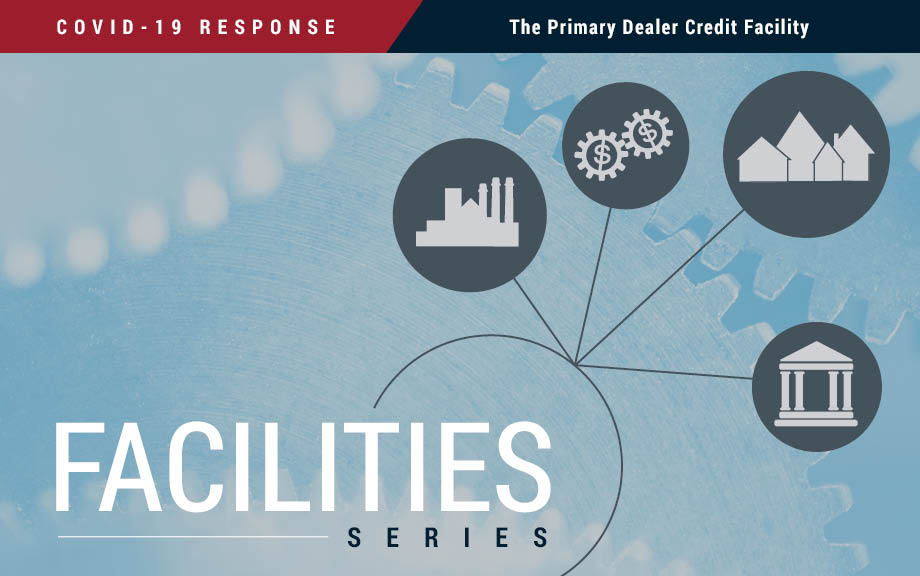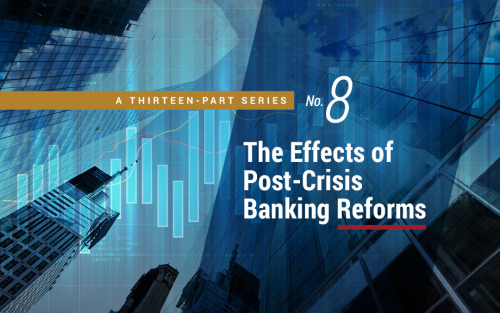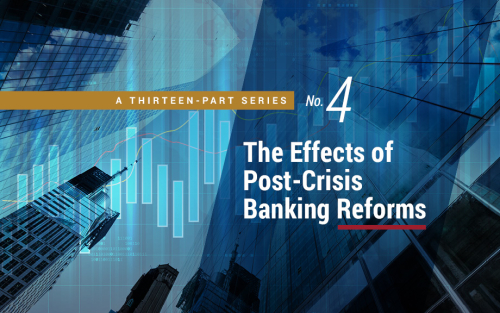How Has Post‑Crisis Banking Regulation Affected Hedge Funds and Prime Brokers?

“Arbitrageurs” such as hedge funds play a key role in the efficiency of financial markets. They compare closely related assets, then buy the relatively cheap one and sell the relatively expensive one, thereby driving the prices of the assets closer together. For executing trades and other services, hedge funds rely on prime brokers and broker-dealers. In a previous Liberty Street Economics blog post, we argued that post-crisis changes to regulation and market structure have increased the costs of arbitrage activity, potentially contributing to the persistent deviations in the prices of closely related assets since the 2007–09 financial crisis. In this post, we document how post-crisis changes to bank regulations have affected the relationship between hedge funds and broker-dealers.
The Banking Industry and COVID‑19: Lifeline or Life Support?
By many measures the U.S. banking industry entered 2020 in a robust state. But the widespread outbreak of the COVID-19 virus and the associated economic disruptions have caused unemployment to skyrocket and many businesses to suspend or significantly reduce operations. In this post, we consider the implications of the pandemic for the stability of the banking sector, including the potential impact of dividend suspensions on bank capital ratios and the use of banks’ regulatory capital buffers.
Implications of the COVID‑19 Disruption for Corporate Leverage

The COVID-19 pandemic has caused significant economic disruptions among U.S. corporations. In this post, we study the preliminary impact of these disruptions on the cash flow and leverage of public U.S. corporations using public filings through April 2020. We find that the pandemic had a negative impact on cash flow while also reducing corporations’ interest expenses. However, the cash flow shock far outpaced the benefits of lower interest payments, especially in industries that were disproportionately levered. Looking ahead, we find that a sizable share of U.S. corporations have interest expense greater than cash flow, raising concerns about those corporations’ ability to endure further liquidity shocks.
Insider Networks

Erol and Lee consider the cat-and-mouse game played between financial regulators and those attempting to trade on inside information, including how insiders might form networks in order to circumvent restrictions, and how regulators might cope with insiders’ tactics.
The Primary Dealer Credit Facility

On March 17, 2020, the Federal Reserve announced that it would re-establish the Primary Dealer Credit Facility (PDCF) to allow primary dealers to support smooth market functioning and facilitate the availability of credit to businesses and households. The PDCF started offering overnight and term funding with maturities of up to ninety days on March 20. It will be in place for at least six months and may be extended as conditions warrant. In this post, we provide an overview of the PDCF and its usage to date.
How Does Supervision Affect Bank Performance during Downturns?

New research finds that there is a cyclical nature to the benefits of bank supervisory attention: in normal times, the benefits are smaller, but during downturns the more closely supervised banks exhibit better loan performance and lower earnings volatility.
Banking System Vulnerability: Annual Update

A key part of understanding the stability of the U.S. financial system is to monitor leverage and funding risks in the financial sector and the way in which these vulnerabilities interact to amplify negative shocks. In this post, we provide an update of four analytical models, introduced in a Liberty Street Economics post last year, that aim to capture different aspects of banking system vulnerability.
What Happens When Regulatory Capital Is Marked to Market?

Minimum equity capital requirements are a key part of bank regulation. But there is little agreement about the right way to measure regulatory capital. One of the key debates is the extent to which capital ratios should be based on current market values rather than historical “accrual” values of assets and liabilities. In a new research paper, we investigate the effects of a recent regulatory change that ties regulatory capital directly to the market value of the securities portfolio for some banks.
Why Do Banks Target ROE?

Nonfinancial corporations focus on the growth in earnings per share (EPS) to benchmark their performance. Banks used to follow a similar practice, but starting in the late 1970s they began to emphasize return on equity (ROE) instead. In this blog post, we outline findings from our recent staff report, which argues that banks had an incentive to make this change when their charter values eroded owing to increased competition, and the incentive to change was magnified by risk-insensitive deposit insurance.
The Cost of Regulatory Capital

Banks contend that equity capital is expensive and that an increase in capital requirements will adversely impact bank services, including the volume and cost of mortgages and corporate loans. For example, JPMorgan CEO Jamie Dimon said in 2017 that “It is clear that the banks have too much capital…and more of that capital can be safely used to finance the economy.” In a recent staff report, we compare the different treatments of short-term credit commitments under the Basel I and Basel II Accords to assess the effect of capital regulation on banks’ cost of capital. Our results suggest that banks are willing to pay at least $0.04 to reduce their regulatory capital by one dollar.














 RSS Feed
RSS Feed Follow Liberty Street Economics
Follow Liberty Street Economics